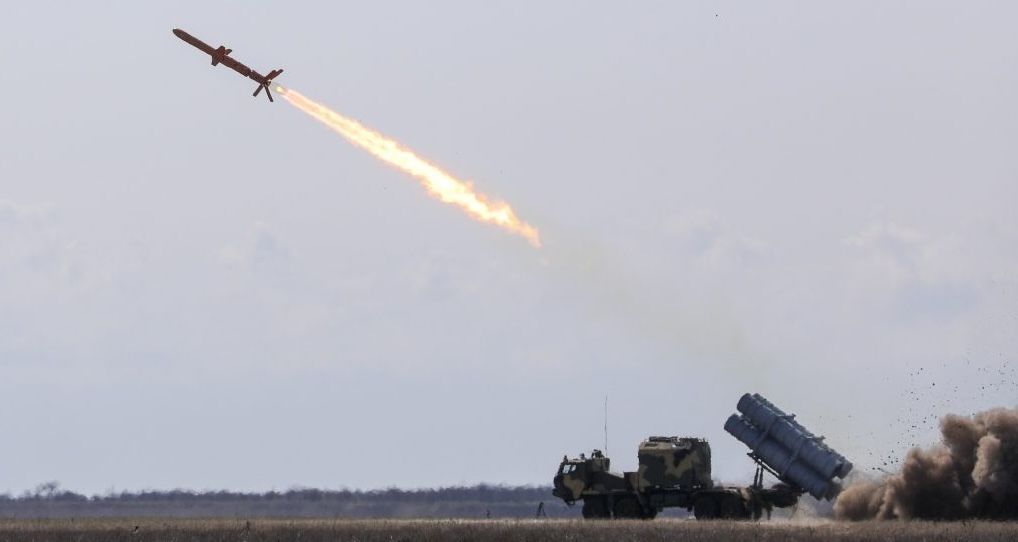Ukraine says it has the know-how to produce more much-needed drones as well as missiles for strikes deep into Russia, and all it needs is financial backing from Western allies.
“We’ve got all the knowledge, we’ve got all the capabilities in place,” Alexander Kamyshin, advisor to President Volodymyr Zelensky for strategic affairs, told the Kyiv Independent on Oct. 24.
Kamyshin, the former Minister of Strategic Industries who has overseen Ukraine’s domestic weaponry manufacturing for a year and a half before taking on his new advisor role last month, said Kyiv is asking allies for financial backing to achieve its battlefield-tested innovation and production potential.
He spoke after a months-long push by Zelensky and other Ukrainian officials pleading for the U.S. and other allies to approve the use of their missiles for strikes deep inside Russia, an effort which Kyiv appears to have not given up on despite an apparent lack of success.
Ukraine has so far relied heavily on massive weaponry supplies from NATO members, but Kamyshin said Ukraine could, on its own with funding, produce more sophisticated kit using priceless experience gained through more than two and a half years of fighting back against Russia’s full-scale invasion.
 Alexander Kamyshin in Berlin, Germany, Sep. 19, 2022. (Carsten Koall/picture alliance via Getty Images)
Alexander Kamyshin in Berlin, Germany, Sep. 19, 2022. (Carsten Koall/picture alliance via Getty Images)
“Our capabilities are significantly higher than the funding available, so it’s a significant amount of money, but we discuss it with our partners,” Kamyshin said, declining to disclose the estimate needed.
“Our capabilities are significantly higher than the funding available.”
President Volodymyr Zelensky told journalists on Oct. 21 that the U.S. is expected to provide Ukraine with $1.6 billion for its domestic long-range weapon production. Ukraine would receive the first tranche of $800 million in the “coming days,” and the second tranche of $700 million to $800 million afterwards, the president said after this week’s visit of U.S. Defense Secretary Lloyd Austin to Kyiv.
Defense Minister Rustem Umerov said at a September event that Ukraine’s potential for domestic production could reach $20 billion with foreign investment — more than three times the estimated 2024 projection from last year.
Western allies’ apparent shift of focus to allocating substantial money on Ukraine’s long-range strike development rather than providing their own kits comes after Kyiv’s months-long pleas for permission to strike deep into Russia with Western weaponry yielded no results.
The future of Western military aid is becoming ever more uncertain, with the high-stakes U.S. presidential election coming up in early November. Both presidential candidates remain vague on their Ukraine policy, with Republican candidate Donald Trump skeptical about further U.S. support for Kyiv and Vice President Kamala Harris on the Democratic ticket not addressing it in detail.
Though Moscow has the initiative across most of the front line, Kyiv has regularly struck targets such as arms depots, oil refineries, and airfields hundreds of kilometers inside Russia. For Ukraine, the slingshot strikes deep into Russia are essential to reduce the bigger foe’s combat capability from afar.
Ukraine’s victory delayed by West’s fears of Russian defeat, Canadian-Ukrainian lawyer turned soldier says
Daniel Bilak is a Canadian-Ukrainian lawyer living in Ukraine for decades, taking on critical roles in what has been a rollercoaster career amidst Ukraine’s fight to prosper while defending its freedom. He has played a big role in attracting investment into the country, first as a lawyer and later,…

“We proved that we can reach deep inside Russia, and for that reason, we believe that funding the procurement of things made in Ukraine is a good move for our partners,” Kamyshin said, referring to the series of strikes.
His comments also refer to technological advancements made by Kyiv that could be shared with allies in fast-developing future warfare tactics, including the massive use of drones in the air, on the ground, and at sea in an asymmetric war where Russia has the conventional firepower advantage.
Kamyshin said that Ukraine has “commitments” from allies, including the U.S., Denmark, and Lithuania, to fund the procurement of Ukrainian-made deep-strike capabilities.
“So, at this point, we are at the point of finalizing arrangements on funding this procurement,” Kamyshin said.
AeroVironment plans to start producing Switchblade kamikaze drones in Ukraine
The U.S.-based AeroVironment signed an agreement with a Ukrainian company to localize its production of Switchblade 600 loitering munitions, marking the latest of several recent agreements between Ukrainian and foreign companies to produce weaponry in Ukraine.

A growing number of Western allies are funding Ukrainian weaponry development and have taken on joint production projects to compete against Russia’s massive Soviet-era stocks with cutting-edge technologies.
U.K. Defense Secretary John Healey also said on Oct. 22 that his country would lend almost $3 billion for the production of long-range drones.
Lithuania announced in September that it is investing $11 million in the development of Ukraine’s long-range “Palianytsia” weapon. Zelensky confirmed the first successful use of the new Ukrainian “missile drone” in late August.
“All co-production and all investments in defense manufacturing are very important to us. This is a priority today,” Zelensky said during the visit of Lithuanian President Gitanas Nauseda in September.
“Right now, everyone can see how successful Ukraine is in developing and deploying its long-range weapons and long-range drones.”
Zelensky said at the Second International Forum of Defense Industries in October that Ukraine can now produce 4 million drones a year and already has contracts to manufacture 1.5 million. Ukraine has refrained from revealing more about missiles due to sensitivity of the issue.
‘We believe that in 5 years, Ukraine’s defense sector will attract half a billion dollars:’ Q&A with foreign defense investors
Ukraine has become a hotbed of defense innovation, as Russia’s deadly invasion fuels a rapid development of new battlefield technologies. Kyiv now aims to become a global leader in the defense sector, but with its economy drained by the war, it needs foreign investment to accomplish its goal. Ukra…

Kamyshin declined to reveal the details about the long-range weapons being developed, including whether they would include Ukraine’s homemade Hrim-2 (Grim-2) ballistic missile. Another Ukrainian-developed missile, the Neptune, was used in 2022 to sink the Moskva, the flagship of Russia’s Black Sea Fleet based in the occupied Crimean Peninsula.
Ukraine has come a long way in honing its homemade drones to bring the war to Russia. Kamyshin said Ukraine started striking deep inside Russia in late 2023, and the Ukrainian engineering capabilities have been “growing on and on.”
“We see an increase in the interest of our Western allies in funding things procured from Ukrainian producers,” Kamyshin said.
“We proved that they are capable.”

Reporter
Asami Terajima is a reporter at the Kyiv Independent. She previously worked as a business reporter for the Kyiv Post focusing on international trade, infrastructure, investment and energy. Originally from Japan, Terajima moved to Ukraine during childhood and completed her bachelor’s degree in Business Administration in the U.S. She is the winner of the Thomson Reuters Foundation’s Kurt Schork Award in International Journalism 2023 (Local Reporter category) and the George Weidenfeld Prize, awarded as part of Germany’s Axel Springer Prize 2023. She was also featured in the Media Development Foundation’s “25 under 25: Young and Bold” 2023 list of emerging media makers in Ukraine. Read more
